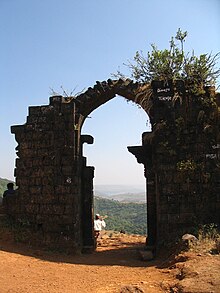Vishalgad
This article includes a list of references, related reading, or external links, but its sources remain unclear because it lacks inline citations. (October 2012) |
| Vishalgad | |
|---|---|
| Kolhapur district, Maharashtra, India | |
 One of the few surviving structures on Vishalgad | |
| Site information | |
| Owner | |
Vishalgad (also called Khelna or Khilna) was one of the important forts of Shivaji and Maratha Empire. The name ‘Vishalgad’ meaning grand fort in Marathi, was given by Shivaji after annexing it for the Maratha Empire in 1659.The fort is about 1130 metres that is 3630 feet.
Origin of the name Vishalgad
Khelna was in the control of Adilshah of Bijapur. Shivaji wanted to conquer the fort but the terrain of the fort was difficult; conquering the fort was easier said than done. Shivaji attacked the fort but the Adilshahi garrison at the fort was defending the fort valiantly. Then, Shivaji came up with a plan. Accordingly, a group of Marathas went up to the fort and convinced the Adilshahi commander (killedar) of the fort that they were not content with the rule of Shivaji and thus, had come to serve the Adilshah. The Marathas were successful and the next day, they revolted and caused total chaos inside the fort. Simultaneously, Shivaji attacked the fort from outside and in no time captured the fort. Shivaji renamed the fort as Vishalgad.
Location
The fort is situated in Maharashtra, India. It is 76 km North-West of Kolhapur, 60 km north-west of Panhala fort and 21 kilometers south of Kolhapur Ratnagiri road. It is situated on the hills that divide the region into two parts viz Amba Ghat and Anaskura ghat. Since it is placed on the border of the hilly portion of Sahyadri ranges and the konkan region, it got great political significance in the historical times. It was regarded as a 'Watch tower' for both regions.
Sightseeing
The fort has following sites nearly in ruins today except the Dargah.
- Amruteshwar Temple
- Shri Nrusinha Temple
- Takmak Tok
- Sati’s Vrindavan
- The Dargah or tomb of Hazrat Malik Raihan. Thousands of Devotees visit the Dargah every year.
- Samadhis built in the memory of Baji Prabhu Deshpande and Phulaji Prabhu Deshpande, who laid down their lives to protect Chhatrapati Shivaji from the clutches of Siddhi Johar while escaping from fort Panhala to Vishalgad.
History
- The fort was constructed by the Shilahara king ‘Marsinh’ in 1058 A.D. Initially, he named it as 'Khilgil'
- In 1209, the then king of Seuna Yadavas of Devagiri defeated Shilaharas and captured the fort
- In 1309, Allauddin Khilji defeated King Ramchandra of the Seuna Yadavas of Devagiri and soon the fort was attached to the Khilji Dynasty
- In August 1347, the Mughal chief of the western India Hasan Gangu Bahamani became independent as a result of which the fort became a part of Bahamani Sultanat
- During 1354 to 1433, the fort was under the rule of Vijayanagar Empire
- After the fall of the Vijayanagar Empire, it was captured by a local Maratha king Shankarrao More. Therefore, the Bahamani Sultan sent troops from Bidar under the Generalship of Mahmood Gawan, his then prime Minister, to re-capture it. Gawan's officers Karnasinh Bhonsale and his son Bhimsinha captured the fort with the help of Ghorpad i.e. Giant monitor lizard. Thenceforth, Bhimsinha was conferred with the title Ghorpade.
- In 1489, Yusuf Adil Shah separated himself from the Bahamani kingdom along with the area under his command and founded his independent sultanat at Bijapur. Hence, the fort was attached to Adil Shahi sultanate.
- In 1659, Shivaji captured the fort with the help of the officers on the fort.
- In July 1660, the fort witnessed Shivaji's escape from the Adilshahi blockade around fort Panhala and the Battle of Pavan Khind. Baji Prabhu Deshpande, Shivaji's experienced General and Rango Narayan Orpe, Shivaji's young officer on the fort, defeated Adilshahi troops at Pavan Khind and Gonimooth respectively.
- After Shivaji's death, Chhatrapati Sambhaji would spend most of his times on the fort. He took initiative in renovation and reconstruction of some parts of the fortresses and gates of the fort.
- In 1689, Rajaram Chhatrapati fled to Fort Gingee in Karnataka (now Tamil Nadu) from fort Panhala and thus ‘Vishalgad’ became an unofficial capital of the Maratha empire. Ramchandra Pant Amatya from Vishalgad and Rajaram Chhatrapati from Gingee made several moves and defeated Aurangzeb with the help of Santaji, Dhanaji, Parshurampant Pratinidhi and Shankaraji Narayan Sacheev.
- During the times of Maratha Empire, Vishalgad was made capital of a large region consisting of ninety towns and villages in Kolhapur and Ratnagiri districts. Sardesai and Sarpotdar were officers on the fort since Adilshahi times. Some of the Havaldars (Military In Charge) on the fort during Rajaram Chhatrapati to Chhatrapati Shahu's times were :
- Trimbakji Ingawale - 3 years
- Santaji Kathe - 9 years
- Khandoji Karanjkar - 3 months
- Umaji Gaikwad - 6 months
- Shamji Rangnath Orpe Sarpotdar - 6 years
- Vithoji Nimbalkar - 6 months
- Malji Dalvi - 2 months
- In 1844, as a result of mutiny by the Killedars, British army demolished the entire fort and dismissed the officers there
References
- ‘Kille Vishalgad’ (Marathi) by P.B.Shirwalkar
- 'Pant Pratinidhi Bakhar'(Marathi)
- 'Mudhol Sansthancha Itihas' (Marathi) by Dattopant Apte
- ‘Maharashtrateel Kille’ (Marathi) by S.R.Devale
- 'Mantarlela Itihas' (Marathi) by Harshad Sarpotdar

